
ART FAIR (16-20 November 2022) Sabrina Amrani Gallery at Abu Dhabi Art 2022
Nov 16, 2022 EVENT, Art Fair

In ‘When the day belongs to the night III’ Joel Andrianomearisoa created an artwork that speaks of complex and various landscapes from Madagascar and India, shared experiences and his aesthetic interest in memory and nostalgia. The result is a triptych of monumental construction undergirded by intricate structures, a painting that experiments with fields of colour, and a tapestry that weaves together melancholia, remembrances, and personal narratives.
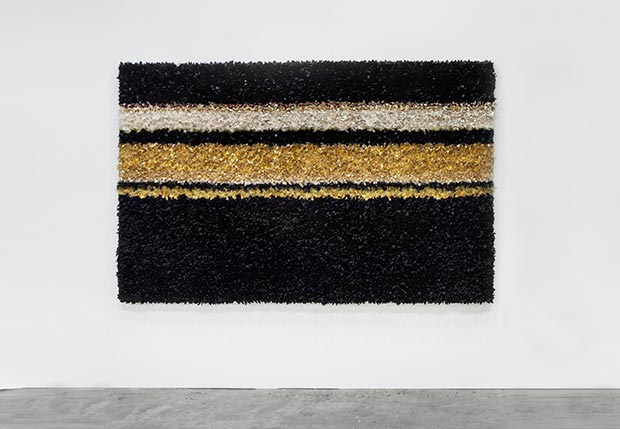 Joel Andrianomearisoa, When the day belongs to the night I, 2018. Textile collage. 290 x 180 cm. Courtesy of the artist and Sabrina Amrani
Joel Andrianomearisoa, When the day belongs to the night I, 2018. Textile collage. 290 x 180 cm. Courtesy of the artist and Sabrina Amrani
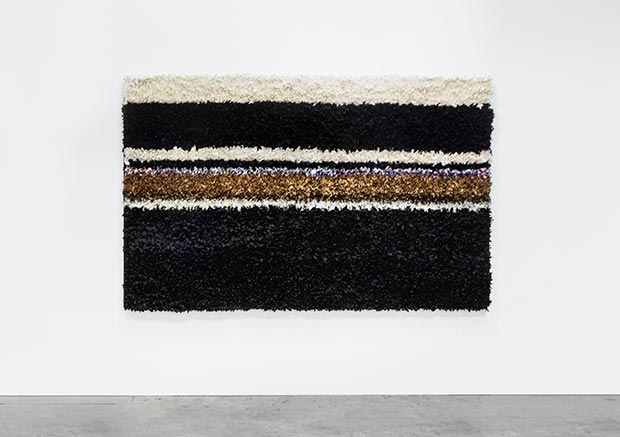 Joel Andrianomearisoa, When the day belongs to the night III, 2018. Textile collage. 290 x 180 cm. Courtesy of the artist and Sabrina Amrani
Joel Andrianomearisoa, When the day belongs to the night III, 2018. Textile collage. 290 x 180 cm. Courtesy of the artist and Sabrina Amrani
'Just Paper' (2022) by Manal AlDowayan focuses on the transformation of a medium, from paper and books, historically linked to the archive and its long shelf life, to delicate porcelain that can be crushed with a single flex of a hand, easily lost and destroyed. It is an exploration of power and weakness within a form. Manal addresses the ideas of healing and survival. She uses the content of a book titled 'The jurisprudence of the Arabic Language' written by Abu Mansour AlThaalby, an Abbasid-era scholar who wrote this book over 1000 years ago. In this book, the author attempted to gather the words of Arabic under specific categories. The artist grew up using this book from her family's library as a tool to enjoy the breadth and depth of the Arabic language. She found this book a perfect source for her artistic practice.
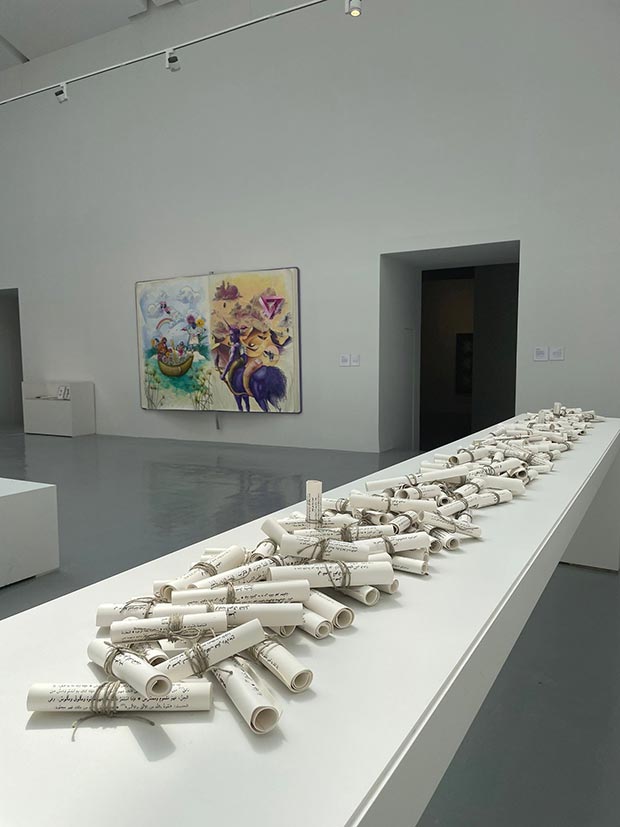 Manal AlDowayan, Just paper - group XIV, 2022. Silkscreen on porcelain and jute string (70 pcs). Courtesy of the artist and Sabrina Amrani
Manal AlDowayan, Just paper - group XIV, 2022. Silkscreen on porcelain and jute string (70 pcs). Courtesy of the artist and Sabrina Amrani
Nicene Kossentini based her series 'Grammar Lessons' on texts by Arab philosophers, thinkers and poets, such as Ibn Khaldun or Khalil Gibran. The calligraphic texts here disappear in an exercise of miniature writing that makes the reading complex and the meaning impossible: works in which famous quotes intertwine, poems superimpose, or history texts dissolve in water. Nicene questions the liquid aspect of culture and tradition, as well as the concepts of identity, civilization and history. How does a civilization survive and evolve when tangible knowledge becomes unintelligible?
Kossentini carefully selected illustrious text fragments, turning them into a landscape of unintelligible characters, even for anyone with knowledge of Arabic script. The manuscripts leave room for a landscape of diluted letters, according to philosopher and art critic Christine Buci-Glucksman: “The thought of the line, its absence in the presence, has invaded everything; past of an illegible writing memory and present of a floating, indecisive landscape. A nothing about nothing that becomes everything.”
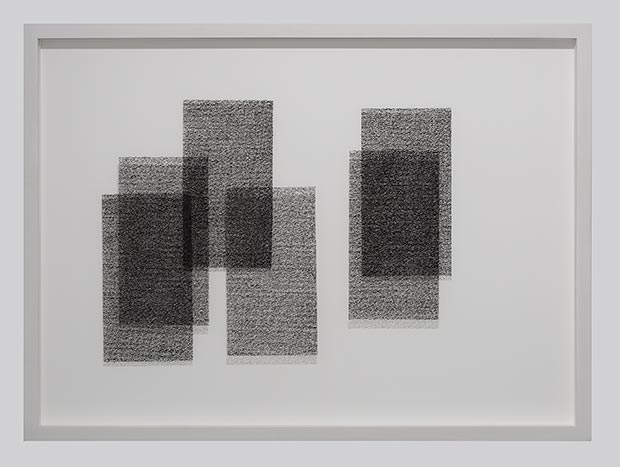 Nicene Kossentini, Grammar Lessons I, 2020. Ink on glass. 65 x 90 cm. Courtesy of the artist and Sabrina Amrani
Nicene Kossentini, Grammar Lessons I, 2020. Ink on glass. 65 x 90 cm. Courtesy of the artist and Sabrina Amrani
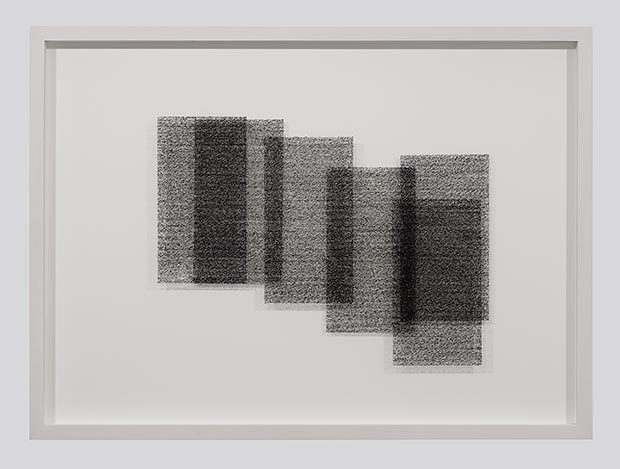 Nicene Kossentini, Grammar Lessons III, 2020. Ink on glass. 65 x 90 cm. Courtesy of the artist and Sabrina Amrani
Nicene Kossentini, Grammar Lessons III, 2020. Ink on glass. 65 x 90 cm. Courtesy of the artist and Sabrina Amrani
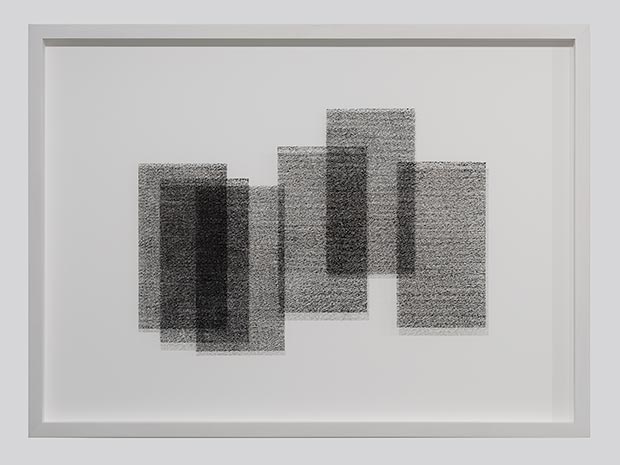 Nicene Kossentini, Grammar Lessons IV, 2020. Ink on glass. 65 x 90 cm. Courtesy of the artist and Sabrina Amrani
Nicene Kossentini, Grammar Lessons IV, 2020. Ink on glass. 65 x 90 cm. Courtesy of the artist and Sabrina Amrani
‘The Hand of The (my) Father’ by Waqas Khan presents large-scale minimalist drawings that resemble webs and celestial expanses. The contemplation of leaving visible evidence on paper is the crux of the work. Khan employs small dashes and minuscule dots to create large entanglements. When two particle-sque units are spread out and entangled, they are essentially 'in sync' with each other, and they'll stay in sync no matter how far apart they are. This idea of togetherness and being seen as a magnanimous totality is what he partly absorbs from his inclination towards literature and interest in the lives of Sufi poets.
Khan's work also evokes a sense of scripting, which he likes to see as a discourse between him and his viewer, a dialogue formatted over the syntax of a monologue.
-Father_2022.jpg) Waqas Khan The Hand of The (my) Father, 2022. Archival ink on wasli paper. 243 × 243 cm. Courtesy of the artist and Sabrina Amrani
Waqas Khan The Hand of The (my) Father, 2022. Archival ink on wasli paper. 243 × 243 cm. Courtesy of the artist and Sabrina Amrani
The series 'I am a sky where spirits live' by Timo Nasseri, emerges from the work that explores the origins and references of the Razzle-Dazzle Camouflage. The Dazzle Camouflage was an irritant camouflage used in WWI on British and American Navy ships, designed by artists. Not to disguise but to irritate the eye and disrupt perception. These patterns combined camouflage from the animal kingdom, indigenous patterns, and Cubist painting based on human perceptual mechanisms.
The basis is a geometric alphabet, which can be understood as a visual language deeply rooted in all cultures. This language has been the centre of Nasseri's work in recent years. The artist uses principles of the formal alphabet and the razzle-dazzle camouflage to work out the unnameable that can be found in this elementary way of shaping. Nasseri sees the paintings as a kind of counterpart, what one could call numinous. At the same time, he often describes them as abstract faces or figures with an inaccessible presence that the words in our spoken language cannot explain. The paintings show how everything in the world and art is connected through the centuries and across borders.
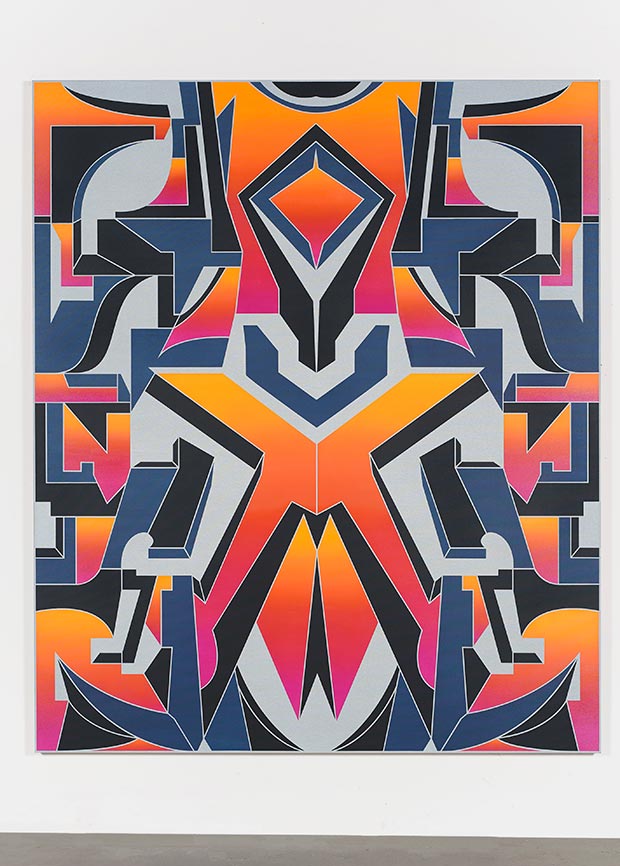 Timo Nasseri, I am a sky where spirits live #3, 2022. Acrylic and oil on canvas on wooden board. 225 x 190 x 4,5 cm. Courtesy of the artist and Sabrina Amrani
Timo Nasseri, I am a sky where spirits live #3, 2022. Acrylic and oil on canvas on wooden board. 225 x 190 x 4,5 cm. Courtesy of the artist and Sabrina Amrani
The series 'Money makes the world go round' by Carlos Aires is based on the lyrics of the song Money Money (1972), a hit by Joel Grey and Liza Minnelli. The work is a deconstruction of the traditional collage technique. It appropriates the images from the mass media, indexed under the criteria of disasters or catastrophes. The artist turns them into silhouettes using original banknotes from the thirty richest countries in the world, according to GDP, to give them definitive form as synthetic miniatures. Finally, he handles their delicate bodies using taxidermy procedures and fixes them to the composition with the help of custom gilded pins. Two silhouettes recur throughout the whole series, the fly and the salamander, both of which refer to the vanitas genre.
In this series, the artist appropriates the concept of the world map in an attempt to generate new cartographies where to locate the essences and contradictions of contemporary societies: vanitas vanitatum omnia vanitas (Vanity of vanities, all is vanity).
_2013--2022.jpg) Carlos Aires, Money makes the world go round VIII (Lizard Edition), 2013- 2022, original banknotes from 30 richest countries in the world (based on the GDP), cardboard, golden pins, Passepartout, gold leaf covered wooden frame. 124 × 174 cm. Courtesy of the artist and Sabrina Amrani
Carlos Aires, Money makes the world go round VIII (Lizard Edition), 2013- 2022, original banknotes from 30 richest countries in the world (based on the GDP), cardboard, golden pins, Passepartout, gold leaf covered wooden frame. 124 × 174 cm. Courtesy of the artist and Sabrina Amrani
Comments
Add a comment
Commenting is not available in this section entry.